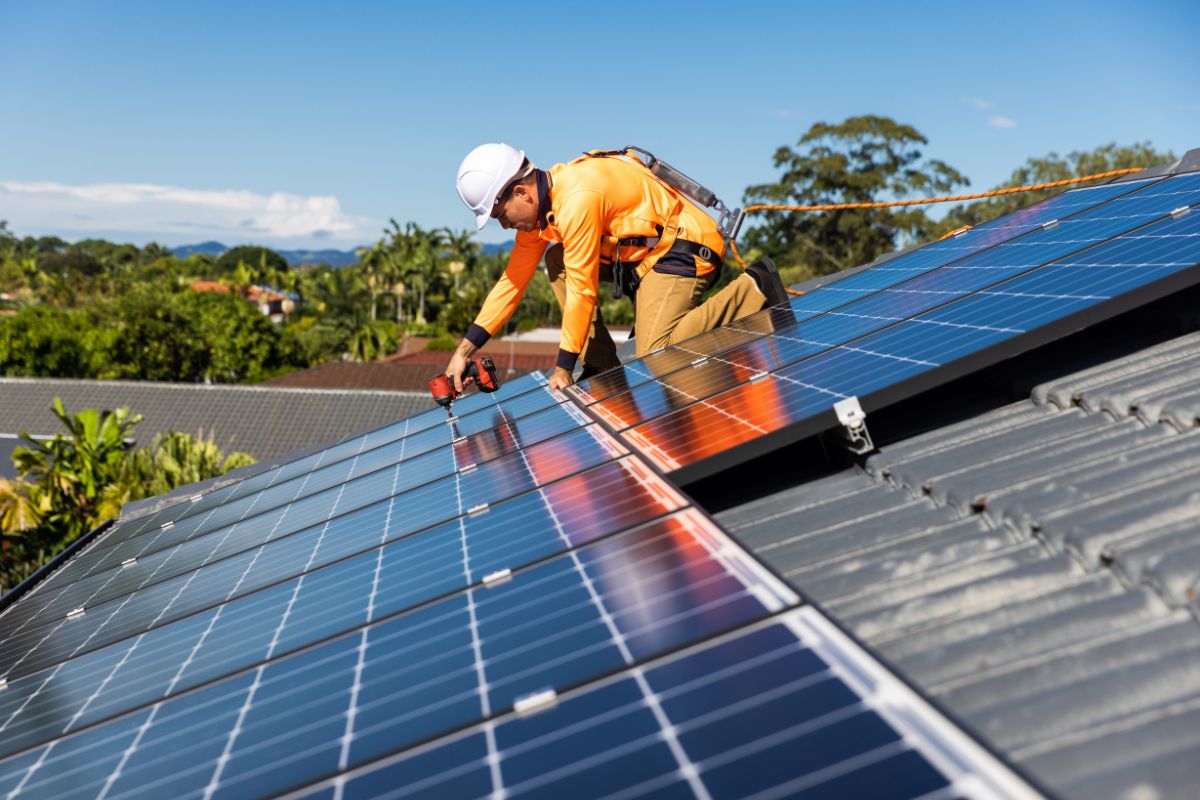Interested in real-world accomplishments and the concrete advantages of solar energy? Let's delve into the comprehensive manual and unleash the potential of solar power for your off-grid lifestyle.
How Solar Panels Work
Solar panels work by converting sunlight into electricity through photovoltaic cells. These cells are made of semiconductor materials like silicon, which absorb photons from sunlight. When sunlight hits the cells, it knocks electrons loose from their atoms, creating an electric current. This process is known as the photovoltaic effect.
You'll typically find these cells grouped together in a solar panel. Each panel generates a direct current (DC), which isn't suitable for most home appliances. That's where an inverter comes in. The inverter converts the DC into alternating current (AC), which powers your tiny house's electrical devices.
To get started, you'll mount the solar panels on your tiny house's roof or another sunny location. The panels need to be angled correctly to maximize sunlight exposure. Once installed, the system requires minimal maintenance. Just keep the panels clean and free from obstructions like leaves or snow.
Monitoring systems can help you track energy production and consumption, ensuring your setup is efficient. By understanding how solar panels work, you can better manage your energy needs and make informed decisions about your tiny house's power system.
Benefits of Solar Energy
By utilizing the power of the sun, you can enjoy numerous benefits that make solar energy an attractive option for your tiny house. First, solar panels offer you a sustainable, eco-friendly energy source. They don't emit harmful pollutants or greenhouse gases, reducing your carbon footprint and helping preserve the planet for future generations.
Another major advantage is the cost savings. While the initial investment might seem high, solar panels can significantly reduce, or even eliminate, your monthly electricity bills. Over time, you'll save money, making solar panels a financially smart choice.
Solar energy also provides you with energy independence. Living off-grid means you're not reliant on traditional power sources, which can be unpredictable and subject to price hikes. With solar panels, you generate your own power, giving you control and peace of mind.
Furthermore, solar panels are low maintenance. Once installed, they require minimal upkeep, letting you focus on enjoying your tiny house lifestyle. Additionally, advancements in solar technology have made panels more efficient and durable, ensuring long-term reliability.
Assessing Your Energy Needs
To effectively power your tiny house with solar energy, you first need to accurately assess your energy needs. Start by listing all the electrical devices and appliances you plan to use. Note their wattage and how many hours each day you'll use them. This will help you calculate your daily energy consumption in watt-hours.
Next, consider the climate and weather patterns in your location. Solar panels produce varying amounts of energy depending on the amount of sunlight they receive. Research the average sunlight hours per day in your area to estimate how much energy your panels can generate.
Don't forget to factor in energy storage. Batteries are essential for storing excess energy produced during sunny days, ensuring you have power during cloudy periods or at night. Determine how much storage capacity you'll need by considering your daily energy usage and how many consecutive days you might go without significant sunlight.
Choosing the Right Panels
Selecting the ideal solar panels for your tiny house involves considering efficiency, size, and cost to guarantee they meet your energy requirements. Begin by assessing the effectiveness of different solar panels. High-efficiency panels convert more sunlight into electricity, which is vital for tiny houses with limited roof space. Monocrystalline panels, although more expensive, offer higher efficiency compared to polycrystalline panels.
Next, take into account the size of the panels. Measure your roof to determine how many panels do you need for a tiny house. Remember, you'll need space for other components like vents or skylights. Compact, high-efficiency panels might be more suitable if roof space is a limitation.
Cost is another important factor. Balance your budget with the need for quality. While cheaper panels might save money upfront, they may not be as durable or efficient. Look for reputable brands that offer warranties and good customer support.
Check the wattage rating to make sure the panels can meet your energy consumption needs. A higher wattage means more power generation. Combine this with your energy assessment to find the right match.
Installation Process
After choosing the perfect solar panels, it's time to focus on the installation process to make sure they operate efficiently on your tiny house. Start by selecting the ideal location. Your roof is typically the best spot, but consider ground-mount options if roof space is limited. Verify the panels face south (in the northern hemisphere) to maximize sun exposure.
Next, secure the mounting hardware. Attach the brackets securely to the roof or ground structure. Make sure they're level and spaced according to the panel manufacturer's guidelines. Once the brackets are in place, mount the solar panels, ensuring they're angled correctly to capture the most sunlight.
Now, connect the panels to the inverter. The inverter is essential as it converts the solar energy into usable electricity for your tiny house. Follow the wiring diagram provided with your solar kit, and double-check all connections for safety and efficiency.
.jpeg)
Battery Storage Options
When establishing a solar power system for your tiny house, it's crucial to think about battery storage options to make certain you have power when the sun isn't shining. Battery storage acts as a reservoir, capturing excess energy produced during sunny periods and releasing it when necessary, like at night or during overcast days. Your primary choices are lead-acid and lithium-ion batteries.
Lead-acid batteries are more economical initially but are bulkier and have a shorter lifespan. They require regular upkeep, such as topping up with distilled water, and they're less effective in energy storage. Nevertheless, if you're on a limited budget, they can be a practical choice.
Lithium-ion batteries, conversely, are pricier but offer a longer lifespan, higher efficiency, and require minimal upkeep. They have a superior energy density, meaning they can store more power in a smaller space—ideal for tiny houses.
When selecting a battery, consider your energy requirements, budget, and space limitations. Adequately sizing your battery storage guarantees you won't run out of power during crucial times. Keep in mind, a dependable battery system is essential to enjoying a smooth off-grid living experience in your tiny house.
Maintenance Tips
Maintaining your solar power system guarantees it operates effectively and prolongs its lifespan. Start by cleaning your solar panels regularly. Dust, debris, and bird droppings can block sunlight, reducing efficiency. Use a soft brush and soapy water to gently clean the panels. Avoid harsh chemicals that might damage the surface.
Check for shading issues. Over time, trees may grow and cast shadows on your panels. Trim back any foliage that blocks sunlight to maintain peak performance. Inspect the system's wiring and connections periodically. Look for any signs of wear, corrosion, or loose connections. Tighten and replace as needed to prevent power loss or safety hazards.
Monitor your energy output. Most modern systems come with apps or monitoring tools that help you track performance. A sudden drop in energy production could indicate a problem that needs addressing. Don't forget to inspect the mounting hardware. Ensure bolts and brackets remain tight and secure, especially after storms or high winds.
Lastly, schedule professional check-ups. Having a technician inspect your system annually can catch potential issues early and keep everything running smoothly. With these simple maintenance tips, you'll maintain your tiny house stays powered effectively year-round.
Real-Life Success Stories
Now that you know how to maintain your solar power system, let's look at some real-life success stories from tiny house owners who have utilized the power of the sun. For instance, Sarah and James transformed their 200-square-foot home into an off-grid sanctuary. Using a 3kW solar panel system, they power everything from their refrigerator to their LED lighting. They've cut their energy costs to virtually zero and enjoy the freedom of living anywhere they choose.
Another inspiring story is from Mark, who lives in a tiny house on wheels. He installed a 2.5kW solar system paired with a battery storage solution. This setup provides him with enough energy to go off-grid for weeks at a time. Mark loves the independence and sustainability his solar panels offer, allowing him to travel without worrying about electricity.
Conclusion
You've now got the knowledge to power your tiny house with solar energy. By understanding how solar panels work, evaluating your energy needs, and selecting the right panels, you're set to adopt eco-friendly living. The installation process and battery storage options guarantee you're always powered up. Regular maintenance keeps everything running smoothly. With real-life success stories as motivation, you're ready to enjoy independence, sustainability, and cost savings with your solar panel system.






Share: